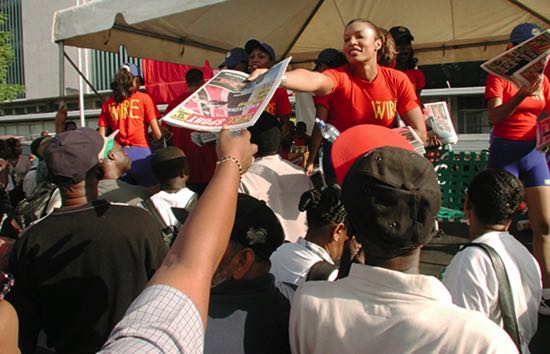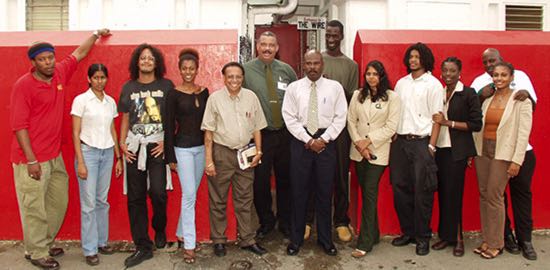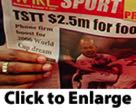Suddenly, ten years later...
12/09/11 22:15 Filed in: Opinion

Carib Girls in Wire branded baby tees hand out copies of the first issue of The Wire at the publication's launch on the Brian Lara Promenade on September 10, 2001. Photograph by Mark Lyndersay.
On September 09, 2001, I was sweating bullets at the Trinidad Publishing Company. It was a Sunday, the very first day of the working week for a new newspaper that would hit the streets the following Monday morning and ran for the next 18 months, five days a week.
I was, according to the paper’s masthead, its Operations Manager, a role I’d managed to win after writing a four page plan for the paper and spending the next eight weeks doing everything from planning new toilets and designing the desks to specifying the type on the publication with designer Kevan Gibbs.
It would be the culmination of everything I’d ever hoped for in media, shaping the destiny of a publication in the market from the ground up. The paper, of course, failed, and there were many reasons for that. I was responsible for the editorial side of things, with publishing being handled by the Guardian’s print system and the paper, which was absolutely not the Guardian, never found someone to champion its virtues to advertisers with the same enthusiasm I had for its content.
Advertising wasn’t my job on the project, and to this day, I regret not knowing enough, not being mature enough, and not being aggressive enough to make that aspect of the paper’s economy more functional and ultimately sustainable.
I was an editorial man, and my passions and focus remained with the editors who made the paper happen over those sweet and painful months. But if I cared about the editorial, I have to confess; my heart was buried deep in the paper’s photographic department.
The most mature thing I ever did at The Wire was to give up my leadership of the department to Andrea De Silva, and it probably ranks as one of the smartest too. Andrea’s passion for photography ensured that only the best work moved forward to the subeditors and cemented the paper’s reputation as a picture paper.
Embedded in the beginnings of The Wire is another, less well-known fact. It was the first paper to completely abandon film in Trinidad and Tobago. From the start, the four photographers working at the paper, Andrea, Keith Matthews, Karla Ramoo and Curtis Chase were able, using the slingshot of the digital workflow I designed for the paper, to consistently slay the better equipped, better manned photo departments of every other paper in town.
For months after we began, nobody in the business even believed that we were all digital.
I’d chosen the Olympus E10, a bizarre little camera that married the style of a prosumer point and shoot camera with the features of an SLR. It also had the best price in a 4 megapixel camera in 2001 (roughly US$2,000, back then).
I’ll always remember the night I unpacked the gear in my office at The Wire and my hopes that Olympus had put a decent sensor in the impressive metal shell of this new camera. By today’s standards, the camera was glacially slow, prone to sensor noise, heavy and with its built in lens, clumsy to adapt to telephoto or wide-angle use (you attached adapter lenses to the body).
Those cameras outlasted the paper and hammered home, at least in my mind, the advantages of this new medium. I didn’t get one. There was no way to justify it in the budget and it would be months before I could get something better than my Nikon E990 to shoot with, but my hands were full during that time with startup pressures and internal politics.
I look back now on the crude workflow we put in place there and marvel at its robustness.
The two iMacs and eventually, the iBook, on the Wire’s photodesk ran a copy of GraphicConverter for reviewing folders of images and making selects. The only other software in its class was PhotoMechanic, which cost almost five times as much.
The selects were printed from GraphicConverter and moved to a folder for placement on the pages and colour correction by the imaging tech. My good friend Keifel Agostini held down that role the longest (though Kristian De Silva, Andrea’s son, made it a career and is still at it) and trained all the techs who came after him, lucky devils.
Every few weeks, I’d begin harassing Keith, Curtis, Andrea and Karla to begin organising their folders for archiving. This was the one thing I kept my hands on, burning two CDs of each month’s work to increasingly rare Kodak Gold CD ROMs and creating a catalog of the CDs using a free version of Extensis’ Portfolio software, called My Portfolio.
This catalog, available to all the subs to search for photos as well as the photo desk, made it possible to find pictures taken months before under crisis deadlines and along with a stunning archive of entertainment related photos made it possible to publish a picture paper five days a week with less than half the photographers available to our competitors. And we published lots of photos, using many of them large, so they had to be good.
I’ll always remember after shuttering The Wire and merging its assets with the Guardian, the sinking feeling that I had when I realised that the photographic department wouldn’t fit.
A good friend of mine there actually cussed me out when I handed over the collection of CDs. “What the f**k am I going to do with that,” he asked me. “I don’t archive s**t!”
I took offence at those words at the time, bit I really should have taken forewarning.
Despite ever increasing hard disk space and optical disk capacities, amazing improvements in software as browsers, parametric image editors and much improved catalog creation software have come to market, photodesks in Trinidad and Tobago have conspicuously failed to keep pace.
If there was one lesson that came out of The Wire, it was that an elegantly organised workflow and a deep, accessible digital archive could be the engine of great photography regularly delivered. It was a lesson that everyone skipped, it seems. Keith and Karla were the last to leave the Guardian, moving to Newsday and private practice respectively earlier this year.
Andrea eventually became the chief photographer of the Guardian some years before, but left in 2006. Curtis never made the jump to the Guardian, moving from The Wire to Newsday and now The Express, where he’s worked for years now.
Keifel emigrated to the US to finally live with his wife, Vic. Alva Viarruel who did some crime reporting for us at The Wire, is now the chief photographer at the Guardian.
I’m still plugging away at photography, and sometimes I do some photojournalism at the Guardian. I miss the energy of it, but I don’t miss the frustrations of having to depend on other corporate hierarchies for critical supplies and technologies.
I see what’s happening on local photodesks, and it makes me sad to see how little of the technologies available today are being used to streamline the work of photojournalism.
Sometimes I’m tempted to put a hand, but eventually, good sense prevails.
Even in a bluntly declared information age, newspapers are still operating as if the product they produce is the newspaper and not its content. Until that changes, photojournalism in Trinidad and Tobago will continue to be as starved of leveraging resources as it is of talent.

Wire staffers on September 09, 2002 at the rear entrance of the Guardian, then the front entrance to The Wire.
From left, Steve Regis, Joanne Barsatie, Sean Simon, Donna Pierre, Azad Ali, this author, Keith Matthews, Nigel Simon, Sasha Mohammed, Richard Howard, Carla Bridgewater, Trevor Burnett and Andrea De Silva. Photo's probably by Karla Ramoo.
Related...
More Wire pages
9/10
blog comments powered by Disqus

